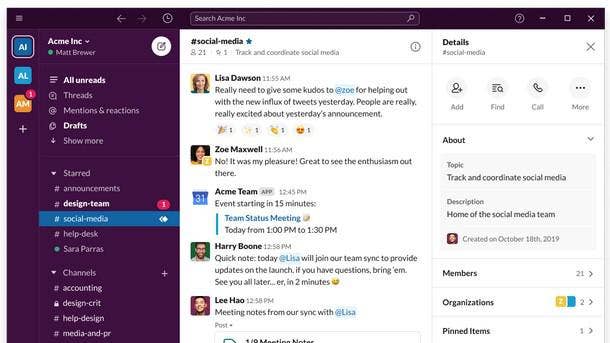The 10 Biggest Microsoft Teams News Stories Of 2020 (So Far)
From massive user growth to feature updates to opportunities for solution providers, here are the top Microsoft Teams news stories we’ve been following this year.

Breakout Year For Teams
Prior to 2020, Microsoft’s Teams collaboration app was already growing fast. But that was nothing compared to what has happened to Teams this year--when the app suddenly became a household name, and a part of people‘s daily lives, amid the shift to remote work and education. As Microsoft CEO Satya Nadella put it in April, the shift to remote has driven an “orders of magnitude increase” in usage of Teams--which is part of Office 365 and offers chat, video conferencing and audio calling. Yet while the number of daily active users of Teams has exploded, Microsoft is also “seeing increased usage intensity across the platform as people communicate, collaborate and co-author content in Teams,” Nadella said in July. Notably, the growth has led Microsoft to double down on development of the Teams platform while also making it increasingly profitable for partners to work with.
What follows is our roundup of the 10 biggest Microsoft Teams news stories of 2020 so far.

10. New Features
Microsoft has initiated a rapid pace of development for the Teams collaboration app as users--and expectations--have increased. In particular, Teams has been getting upgrades around its video capabilities, such as with a feature allowing meeting organizers to instantly “end meeting” by clicking a button in the control bar became available. Microsoft also rolled out virtual backgrounds for Teams video calls and added a ”raise hand” feature--to let meeting participants send a visual cue when they want to speak.
Additionally, Microsoft said it’s looking to improve the video meeting experience with a new AI-driven capability called Dynamic View. With the feature, users will get more control over other participants and shared content are displayed. For instance, users will be able to control their view of shared content and will be able to see specific participants side-by-side if desired, Microsoft said.
Along with launching new features for video meetings, Microsoft said it‘s also tackling personal productivity within Teams. A new app within Teams, the tasks app, offers users a unified view of their tasks across different apps. The tasks app can bring together tasks from Planner, Microsoft To Do and Outlook.

9. Separate Windows For Meetings And Calls
Another new feature rolling out to Teams is the ability to pop out separate windows for meetings and calls in the collaboration app. Previously, Teams has restricted users to using a single window within the app at a time, but Microsoft says that is changing with the debut of “multi-window experiences” in the app. Users get the ability to pop out meetings and calls into separate windows as a way to help “optimize their workflow,” Microsoft said.
Travis Adair, principal partner and vice president of Columbia, Mo.-based InfiniTech Consulting, said that supporting multiple windows is “a useful feature to add” in Teams. “We have heard some complaints from clients [about the] lack of dual windows in Teams. Once a video conference is launched, the video experience consumes the entire Teams window. If you need to reference any previous chat, then your available video is minimized to a very small window,” Adair said in an email to CRN. “Most business users these days have at least two monitors. It makes sense for the application to fully utilize screen real estate.”

8. Video Calls Surge In Challenge To Zoom
Microsoft has reported a massive increase in video calls using its Teams collaboration app during the COVID-19 pandemic, even as other video conferencing apps, such as Zoom and Cisco Webex, have also seen spikes in usage. During March, Teams calls and meetings that used video grew to 43 percent, from 21 percent previously, Microsoft said. All in all, Teams video calls grew by more than 1,000 percent during the month, according to the company. “As the world works remotely, it is no surprise people are turning on video in Teams meetings two times more than before many of us began working from home full-time,” said Jared Spataro, corporate vice president for Microsoft 365, in a blog post.

7. Partner Incentives And Specializations
The explosive growth of Teams has led Microsoft to make some major moves for partners in 2020. For instance, in March, incentive payouts were increased for non-FastTrack partners who work with customers to achieve 15-percent usage in Teams deployments. FastTrack partners also became eligible for a new Teams incentive “at the lowest qualified entitlement level,” Microsoft Channel Chief Gavriella Schuster said. The incentives are being offered through Sept. 30.
Meanwhile, in May, Microsoft announced two new Teams-related advanced specializations that aim to help partners showcase their expertise on the platform. Partners that have expertise in deploying Teams as a calling solution can now earn a new advanced specialization, Calling for Microsoft Teams. And the second new advanced specialization, Teamwork Deployment, is for partners with Teams deployment services practices that also bring a focus on SharePoint Online, Exchange Online and Yammer.

6. Slack Antitrust Complaint
The growth of Teams has also led to pushback from one of the app’s biggest rivals, Slack. The company announced in July that it has filed an antitrust complaint against Microsoft with the European Commission. The filing relates to the bundling of Teams with the widely used Office 365 suite. “Microsoft has illegally tied its Teams product into its market-dominant Office productivity suite, force installing it for millions, blocking its removal, and hiding the true cost to enterprise customers,” Slack said in a news release.
Microsoft responded to the Slack complaint to argue that Teams offers a differentiator around video collaboration, which has driven the platform’s strong growth in users. “We created Teams to combine the ability to collaborate with the ability to connect via video, because that’s what people want. With COVID-19, the market has embraced Teams in record numbers while Slack suffered from its absence of video-conferencing,” Microsoft said in a statement. Slack does offer video calling, but has not emphasized the feature to the degree that Microsoft has for Teams. Slack did not respond to a request for comment on Microsoft’s statement.

5. Together Mode
Microsoft is seeking to make the latest feature addition to the Teams app, Together Mode, into the next big game-changer for video conferencing. Using AI segmentation technology, Together Mode places participants in a video meeting into a shared virtual background. The idea is to make participants feel more like they‘re sitting together in the same room, Microsoft said.
Together Mode is an improvement because it lets users focus on the body language and faces of other users, according to the company. That makes it easier to catch nonverbal cues, Microsoft said.
With general availability targeted for August, the first shared background to launch for Together Mode will be an auditorium. Teams will get additional shared backgrounds in the future such as a conference room, cafe or classroom, Microsoft said. “It‘s a very interesting feature – a great way to have meeting-goers feel some togetherness,” said Michael Goldstein, president and CEO of LAN Infotech, a Microsoft partner in Fort Lauderdale, Fla. “The individualism [of different backgrounds] really reminds users how separated we are in these meetings.”

4. Video Participants Expansion
Microsoft has been busy addressing one of the biggest limitations for its Teams video calls when compared to other popular video conferencing tools such as Zoom. In the spring, Microsoft rolled out a 3 x 3 grid for viewing nine participants simultaneously--up from four visible participants previously. And Teams is in the process of getting another expansion of its gallery view for video calls, this time enabling Teams video for up to 49 visible participants. Notably, moving to a 49-person gallery view will bring Teams to parity with Zoom. With Teams, “Microsoft has shown some real leadership in surveying the current space and pushing out new user features,” Goldstein said.

3. Teams For Free
While businesses flocked to Teams as online collaboration became an essential need virtually overnight, one well-timed move by Microsoft in particular helped to jumpstart a significant portion of the growth. Microsoft actively sought to boost Teams usage during the coronavirus outbreak and the resulting rise in remote work: On March 5, the company announced it would offer a free Office 365 E1 subscription for six months to businesses and educational institutions that weren’t currently licensed for Teams. The free Teams subscription has been “very popular,” Schuster said in an interview with CRN--driving many businesses to try out, and ultimately opt to stick with, the Teams platform for their collaboration needs.

2. Partner Opportunities
Microsoft executives credited solution providers with playing a pivotal role in enabling Teams for the massive spike in users in recent months. InfiniTech Consulting, for instance, has been doing a “massive amount of work” with Teams amid the shift to remote work, Adair said. “Many clients are rapidly adopting Teams for internal and external communications, and are loving the identity integration and app integrations with their existing Office 365 stack,” Adair said.
And yet, adoption is only the beginning of the opportunity with Teams, Schuster said. Partners can also do the “change management around true collaboration—helping customers really understand how to share documents, how to do the white-boarding, how to more effectively engage on an ongoing basis—and go beyond meetings and chat,” she said in an interview with CRN.

1. User Growth
The biggest news story of Teams in 2020 so far is, without a doubt, the stunning growth in users for the collaboration app. Teams has surged past 75 million daily active users, according to the latest figures provided by Microsoft, as of late April. By comparison, as of last November, the Teams user base was just a bit over a fourth of that amount--with 20 million daily active users. On March 19, Microsoft reported that Teams had added 12 million daily users in just the previous week, as workplaces suddenly turned to the tool as a remote-work solution. Ultimately, Schuster (pictured) told CRN, Teams is just one example of how Microsoft’s emphasis on shifting to cloud has positioned the company and its partners to respond during the COVID-19 crisis. “We’ve been working toward this,” she said – “even though we had no idea” what exactly was coming.
“If you look for a silver lining, it is that I think our partners were very well prepared. A lot of the solutions that we‘ve been working on helping them build fit well into what customers need right now,” Schuster said.